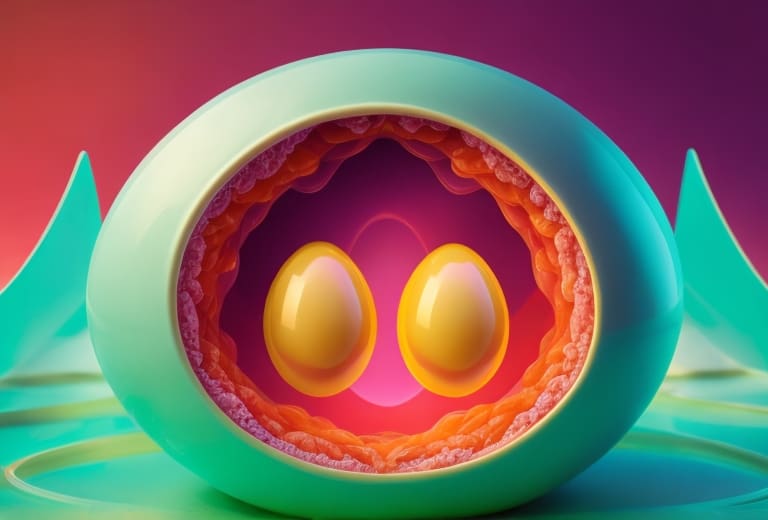Ovulation is a natural physiological process that occurs each month in a woman’s menstrual cycle, and it can sometimes be accompanied by symptoms such as nausea.
Ovulation nausea is a phenomenon experienced by some women, and it is believed to be caused by hormonal fluctuations that occur during this time. This sensation of nausea can be distressing, especially for those trying to conceive, as it may be mistaken for early pregnancy symptoms.
Understanding the duration of ovulation nausea is essential for women who experience this symptom, as it can help manage expectations and alleviate anxiety surrounding their menstrual cycle.
The duration of ovulation nausea can vary greatly among women and can be influenced by factors such as overall health, hormonal balance, lifestyle, and other underlying conditions.
Key Takeaways
- Ovulation nausea arises from hormonal fluctuations during the menstrual cycle
- The duration of this nausea varies among women and can be influenced by multiple factors
- Understanding the duration can help manage expectations and alleviate anxiety
Understanding Ovulation
Ovulation is the process in which a mature egg is released from the ovary. It is a crucial phase in the menstrual cycle and plays a vital role in fertility. During the menstrual cycle, a follicle in the ovary matures and releases an egg, which then travels through the fallopian tubes and becomes available for fertilization.
Hormonal changes in the body, specifically the rise in luteinizing hormone (LH), stimulate ovulation. Basal body temperature, or the resting temperature of the body, may also rise slightly during ovulation.
To monitor their ovulation, some women use ovulation predictor kits (OPKs) that detect the surge in LH levels. The increase in LH typically occurs 24 to 36 hours before the mature egg is released from the ovary.
Mittelschmerz is a German term referring to the pain or discomfort some women experience during ovulation. It is one of the physical signs of ovulation, along with changes in cervical mucus and slight abdominal cramping.
The presence of mittelschmerz can help some women identify their fertile window – the time in their cycle when they are most likely to conceive.
In summary, ovulation is a complex but essential process in the menstrual cycle, involving the release of a mature egg from the ovary. Hormonal changes, specifically the rise in luteinizing hormone, are key in triggering ovulation.
Ovulation predictor kits, mittelschmerz, and changes in basal body temperature are just some of the methods that can assist women in identifying their most fertile days.
Identifying Ovulation Symptoms
Ovulation occurs when a mature egg is released from the ovary, making it available for fertilization. During this period, various physical symptoms may signal that ovulation is taking place.
These symptoms can range from mild to severe, lasting for a few hours or even days.
One of the most common ovulation symptoms is pain or discomfort in the lower abdomen. This sensation, often referred to as ovulation pain or “mittelschmerz,” can be sharp or cramping, and may last for just a few moments or persist for several hours.
The pain typically occurs on one side of the abdomen, as the ovary that releases the egg alternates between cycles.
Another common symptom is an increase in body temperature. A woman’s basal body temperature may rise slightly during ovulation, typically by about 0.4 to 1 degree Fahrenheit.
Tracking this change can help identify the time of ovulation, although it is more effective when combined with other monitoring methods.
Vaginal discharge is another possible sign of ovulation. During this time, the body produces a clear, stretchy, and slippery discharge, resembling raw egg whites.
This change in discharge can be an indicator of increased fertility, as it assists sperm in reaching the egg.
Some women may also experience breast tenderness, similar to the sensation experienced before menstruation. Additionally, light spotting or vaginal bleeding can occur when the egg ruptures from the ovary, although this symptom is less common.
In some cases, women may also notice increased saliva production during ovulation. This can be measured using a saliva test, which checks for the presence of fern-like patterns that indicate ovulation is occurring or about to occur.
It is important to remember that these symptoms may vary from one individual to another, and their presence or absence does not definitively confirm whether ovulation has taken place. Nevertheless, being aware of these signs can provide valuable information for those tracking their fertility, especially for couples trying to conceive.
To avoid pregnancy, it is crucial to use contraception, as engaging in unprotected sex during ovulation increases the likelihood of conception.
The Ovulation Nausea Phenomenon
Ovulation nausea is a relatively common symptom experienced by some women during their monthly reproductive cycle. It is often accompanied by other signs of ovulation, such as abdominal pain, increased body temperature, and changes in vaginal discharge.
This phenomenon occurs as a result of hormonal fluctuations taking place as the body prepares for the release of an egg.
There are several health factors that can influence the severity and duration of ovulation-related nausea. A woman’s general health, her diet, and stress levels can all impact the symptoms she experiences during this time.
Although it can vary from person to person, ovulation nausea generally lasts for a short period, typically a few hours to a day.
For many women, nausea during ovulation can be an uncomfortable experience disrupting daily activities. However, there are ways to manage and alleviate the discomfort.
Some suggestions include staying hydrated, eating smaller meals at regular intervals, and incorporating ginger or vitamin B6 supplements, as they are known to aid in nausea relief.
In addition to nausea, other symptoms might be present during ovulation. These can include tender breasts, increased libido, and mood swings.
If nausea becomes severe or is accompanied by vomiting or other concerning symptoms, it is essential to consult a healthcare professional for a proper evaluation.
While the ovulation nausea phenomenon may not be pleasant, it is generally manageable and short-lived. By understanding the body’s natural response to hormonal changes and taking steps to alleviate discomfort, women can navigate this temporary phase with confidence and ease.
Duration of Ovulation Nausea
Ovulation nausea is a symptom experienced by some women during their monthly menstrual cycle. This nausea tends to arise when the ovary releases an egg, which typically occurs around the middle of the cycle.
The duration of ovulation nausea varies between individuals and can also change from one cycle to another.
For many women, ovulation nausea lasts only a few hours and is relatively mild. In some cases, it can persist for a day or two, but generally subsides as ovulation comes to an end.
It is important to note that the severity and duration of nausea during ovulation may be influenced by factors such as stress, diet, and overall health.
There are several reasons why women may experience nausea during ovulation. One possibility is that the hormonal changes associated with ovulation can cause an upset stomach.
Additionally, the release of the egg may cause a small amount of fluid to remain within the abdominal cavity, leading to discomfort and nausea.
While ovulation nausea can be uncomfortable, there are ways to manage and alleviate the symptoms. Maintaining a healthy diet, staying hydrated, and getting enough rest can help reduce the severity of nausea.
Over-the-counter medications, such as antacids or anti-nausea drugs, may also provide relief in some cases. It is recommended to consult a healthcare professional if symptoms become severe or persistent.
In summary, the duration of ovulation nausea can vary from a few hours to a couple of days, although most women experience only mild discomfort.
Maintaining a healthy lifestyle and seeking medical advice when necessary can help manage this symptom during the menstrual cycle.
Factors Impacting Ovulation
Various factors can impact ovulation and a woman’s overall fertility. It is essential to consider these factors when trying to understand ovulation patterns and the resulting symptoms, such as nausea.
Stress can have a significant effect on ovulation since it may cause hormonal imbalances in the body. Prolonged stress can lead to irregular periods, making it difficult to predict ovulation and gauge fertility.
Managing stress through relaxation techniques, exercise, and a healthy diet can help improve hormonal balance and promote regular ovulation.
Birth control methods may also impact ovulation. Hormonal contraceptives, such as birth control pills, work by suppressing ovulation and preventing the release of an egg.
When discontinuing birth control, it may take some time for a woman’s body to resume normal ovulation patterns. In some cases, it can take several months for periods and ovulation to become regular again.
Polycystic ovary syndrome (PCOS) is a common health issue that can affect ovulation. PCOS is a hormonal disorder that causes small cysts on the ovaries and often results in irregular periods or the absence of periods altogether.
Women with PCOS may experience infrequent or prolonged ovulation, which can make it challenging to predict when they are most fertile. Seeking medical attention for PCOS is recommended to understand ovulation patterns and explore options for managing the sydrome, such as hormone therapy or lifestyle changes.
The overall health of a woman can also influence ovulation. Maintaining a healthy body weight, engaging in regular exercise, and consuming a balanced diet can support reproductive health.
Extreme weight loss or gain, intense exercise, or poor nutrition can all disrupt the menstrual cycle and negatively impact ovulation.
In conclusion, it is essential to consider various factors when trying to understand how long ovulation nausea lasts. Adjustments in lifestyle, management of stress, and seeking medical attention for conditions like PCOS may help regulate ovulation, making it more predictable and manageable.
Ovulation-Related Disorders
Ovulation-related disorders can impact a woman’s fertility and overall health. One common symptom that some women experience during ovulation is nausea. This symptom typically lasts for a few hours to a few days.
However, there are various other ovulation-related disorders that can cause more severe and persistent symptoms.
Endometriosis is a condition in which the tissue that lines the uterus (the endometrium) grows outside the uterus. This can lead to pain, especially in the lower abdomen, as well as heavy menstrual bleeding and cramping. In some cases, endometriosis can cause infertility.
Treatment options include medications such as naproxen to manage pain, hormonal therapies like birth control pills, and surgery to remove endometrial tissue or scar tissue.
Ovarian cysts are fluid-filled sacs that develop on or in the ovary. While many cysts are harmless and resolve on their own, some cysts may cause pain, especially during ovulation.
If a cyst ruptures, it can result in severe abdominal pain and potentially internal bleeding. In severe cases, surgical removal of the cyst may be necessary.
Polycystic ovary syndrome (PCOS) is a hormonal disorder that causes enlarged ovaries with small cysts on the edges. Women with PCOS often experience irregular periods, heavy menstrual bleeding, and fertility issues.
Treatment options for PCOS include weight loss if needed, a healthy diet, exercise, and medications such as birth control pills or ovulation-inducing medications.
Ectopic pregnancy refers to a fertilized egg that implants outside the uterus, often in the fallopian tube. It can cause severe abdominal pain and can be a life-threatening condition if left untreated. Prompt diagnosis and treatment are essential, which may include medication or surgery.
Ovulation-related disorders may also be associated with infections, such as pelvic inflammatory disease (PID). PID is an infection of the reproductive organs, which can cause pelvic pain, irregular periods, and infertility. Treatment for PID typically involves antibiotics.
To detect ovulation-related disorders or track ovulation for fertility purposes, healthcare providers may recommend ovulation predictor kits, menstrual tracking, and regular pelvic exams.
It is essential for women experiencing symptoms or having concerns about their reproductive health to consult with a healthcare provider for proper diagnosis and treatment.
Managing Ovulation Symptoms
Ovulation can bring about various symptoms, such as nausea, bloating, and cramping, which can be uncomfortable for many women. Managing these symptoms can help alleviate discomfort and maintain daily routines.
Estrogen and progesterone, the key hormones in the menstrual cycle, can cause bloating and nausea during ovulation. Over-the-counter medications, like pain relievers and antacids, can help manage these symptoms.
Taking ibuprofen or other anti-inflammatory drugs can alleviate cramping and pain. However, it’s essential to follow dosage instructions and consult a healthcare professional before taking any medication, especially if trying to conceive.
Maintaining a healthy lifestyle is crucial for managing ovulation symptoms. Eating a balanced diet, staying hydrated, and getting regular exercise can help regulate hormone levels and minimize bloating.
Additionally, reducing stress through meditation, yoga, or other relaxation techniques can positively impact the body’s response to hormonal fluctuations.
Topical remedies, such as heating pads or taking a hot bath, can soothe cramping and abdominal pain during ovulation. Applying a heating pad to the lower abdomen or soaking in a warm bath can provide immediate relief and relaxation.
Paying attention to changes in the body, like vaginal discharge and cervical position, can help women understand and manage their ovulation symptoms better. Tracking these changes can also assist in predicting ovulation, which can be beneficial for those trying to conceive or avoid pregnancy.
In some cases, ovulation symptoms might be exacerbated by certain medications, such as antidepressants or other prescribed drugs. It’s essential to consult a healthcare professional if symptoms worsen or persist, as they can recommend alternative treatments or adjust the dosages accordingly.
In summary, managing ovulation symptoms can be achieved through a combination of over-the-counter medications, maintaining a healthy lifestyle, utilizing topical remedies, and staying in tune with the body’s changes.
Consulting with a healthcare professional is always recommended to ensure a tailored approach for managing these symptoms.
Fertility and Conception
Fertility refers to the ability to conceive or achieve pregnancy. It involves complex interactions between hormones, the reproductive system, and one’s overall health. Conception occurs when sperm from a male partner encounters an egg released during ovulation in the female partner’s fallopian tube, leading to fertilization.
One notable indicator of fertility is the basal body temperature (BBT), which is the body’s lowest resting temperature when measured upon waking. A slight rise in BBT often indicates ovulation. Monitoring BBT, along with changes in cervical mucus, can help women track their fertile window – the optimal time for conception.
For women looking to conceive, understanding their menstrual cycle and identifying ovulation signs are crucial. Ovulation predictor kits, which measure hormonal changes in urine, can help determine the most fertile days. Couples might also notice an increased sex drive during this time.
Several factors can impact fertility, including age, overall health, and lifestyle choices. Using birth control methods, such as birth control pills, can temporarily prevent pregnancy.
However, fertility typically returns to normal once these methods are discontinued.
Once conception occurs, the fertilized egg travels down the fallopian tubes and implants itself in the uterus. This process, known as implantation, may cause mild bleeding called implantation bleeding.
In the early stages of pregnancy, a healthcare provider can confirm pregnancy through an ultrasound or additional urine tests.
It’s essential to maintain optimal health and practice family planning when trying to conceive. Monitoring ovulation signs and understanding one’s body’s changes increase the chances of achieving pregnancy and welcoming a new addition to the family.
Related posts:
- Is it Normal to Feel Nauseous During Ovulation
- Can Mucus Make You Throw Up
- Frequent Urination During Ovulation
Frequently Asked Questions
What are common ovulation symptoms besides nausea?
Some common ovulation symptoms besides nausea include mild cramping or pelvic pain, breast tenderness, light spotting, increase in cervical mucus, and an increase in basal body temperature. These symptoms may vary between individuals and not all women experience them.
How can I alleviate nausea during ovulation?
To alleviate nausea during ovulation, it can be helpful to try some of these strategies: eat small, frequent meals; avoid large, greasy or spicy foods; stay hydrated; ginger or peppermint tea may help alleviate nausea; and over-the-counter motion sickness medications may provide relief if nausea is severe.
Does nausea affect fertility and chances of getting pregnant?
Nausea itself does not directly affect fertility and chances of getting pregnant. However, it may affect a person’s comfort during this time, and temporary lifestyle adjustments may be needed to manage ovulation nausea.
Maintaining a healthy lifestyle, including balanced nutrition and regular exercise, is key to optimizing fertility.
Is it normal to have diarrhea along with ovulation nausea?
Diarrhea can occasionally accompany ovulation nausea. This may be due to hormonal changes or an increase in bowel activity around the time of ovulation. It is usually short-lived and should resolve on its own.
However, if diarrhea is persistent or accompanied by other concerning symptoms, consult a healthcare professional.
What are the signs of ovulation to look for?
Some signs of ovulation to look for include changes in cervical mucus (clear, slippery, and stretchy), increase in basal body temperature, mild cramping or pelvic pain, and breast tenderness.
Ovulation predictor kits are also available, which detect the level of luteinizing hormone in your urine, indicating the likelihood of ovulation within the next 24 to 48 hours.
How accurate are ovulation calculators in predicting ovulation?
Ovulation calculators, also known as fertility apps, can provide an estimate for predicting ovulation. However, their accuracy may vary depending on factors such as the regularity of a woman’s menstrual cycle and the information entered into the app.
It is important to note that ovulation calculators are not foolproof and should be used as a general guideline rather than an exact science.

Iesha is a loving mother of 2 beautiful children. She’s an active parent who enjoys indoor and outdoor adventures with her family. Her mission is to share practical and realistic parenting advice to help the parenting community becoming stronger.




